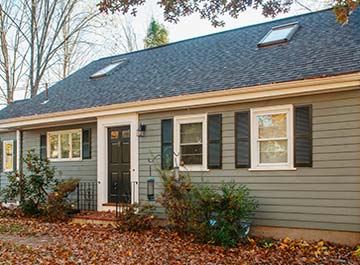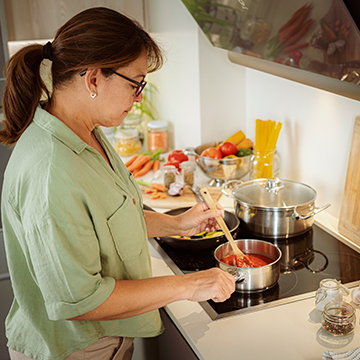Energy-Saving Home Improvement Ideas

Upgrade Your Home Comfort and Efficiency with Your Next Renovation
Looking to revamp your living space? A renovation or remodel is an opportunity to make your home more attuned to your needs – whether that’s to boost comfort, transform the look and feel, or increase the resale value.
Prioritizing energy efficiency in your home improvement project can help achieve all these goals while lowering your energy bills. To make their dream home a reality, New Yorkers can leverage Inflation Reduction Act (IRA) tax credits and State programs and incentives to lower the cost of clean energy equipment and energy upgrades.
8 Energy-Saving Home Improvement Ideas
Here are eight home improvements to enhance your abode with sustainability and energy efficiency in mind.
1. Seal and Insulate
Air sealing and insulation may not transform a home’s aesthetics, but they’ll enhance indoor comfort and deliver energy savings. More than half of home energy use goes to space heating and cooling [1]. Creating a tighter building envelope with air sealing and insulation helps keep heat and cooled air from leaking out and moisture and outside temperatures from creeping in. This increased heating and cooling efficiency can cut home energy use by around 10%, delivering immediate savings for other home improvements [2].
Insulation and air sealing are cost-effective standalone improvements, but it’s also good practice to integrate them into a more comprehensive home project. Larger renovations are often an opportune time to add insulation, especially if key locations like walls or attics will be open to perform other work.
New Yorkers can get a no-cost energy assessment to better understand where their home is wasting energy and identify energy-saving improvements.
Homeowners have options for air sealing and insulating. Recaulking or weatherstripping windows and doorways is a low-cost, DIY option to boost efficiency. For greater energy savings, New Yorkers can install one of several air sealing, insulation, and window upgrade packages and receive at least $1,000 in incentives through the Comfort Home program.
Both renters and homeowners may qualify for low- or no-cost efficiency upgrades, including air sealing and insulation, following an energy assessment through the EmPower+ program.
Air sealing and insulation projects are also eligible for an Inflation Reduction Act (IRA) tax credit. Homeowners can claim a tax credit of up to 30% of the project, capped at $1,200 per year.
2. Upgrade Doors and Windows
Giving the exterior of your home a facelift can simultaneously enhance its curb appeal and energy efficiency. Doors and windows are among the leading culprits for energy loss in a home, making them a prime candidate for an upgrade.
Doors and windows benefit from insulation like the rest of the home. Single-pane glass doors, for instance, lose much more heat than models made of fiberglass, insulated wood, or composite materials. Older doors can experience significant air leakage as the weatherstripping around the threshold wears away. New, energy-efficient doors typically come with adjustable thresholds and sealing systems to minimize air leakage. Alternatively, adding a storm door could be a lower cost solution if the existing door is older but still in good condition.
When considering window replacements, designs with two or more panes of glass offer superior insulation. Keep an eye out for windows with low-emissivity coatings which can reduce energy loss by 30-50% [3]. To get the most efficiency out of existing windows, consider caulking, adding storm windows, or installing window films.
To compare the efficiency of doors and windows, take note of the National Fenestration Rating Council (NFRC) rating. The NFRC label shows several measurements, including the U-factor and solar heat gain coefficient (SHGC). Lower numbers indicate greater efficiency for both.
Windows and doors must meet the ENERGY STAR Most Efficient criteria ![]() to qualify for IRA tax credits in New York State. For windows, this means a U-factor of 0.20 or less and an SHGC at or above 0.20 (Northern Zone) or an SHGC at or below 0.40 (North-Central Zone), depending on where you live. Meanwhile, the requirements for doors vary based on the glazing level. You can find what zone you live in and the IRA eligibility requirements for doors and windows in your area using the ENERGY STAR Climate Zone Finder Tool
to qualify for IRA tax credits in New York State. For windows, this means a U-factor of 0.20 or less and an SHGC at or above 0.20 (Northern Zone) or an SHGC at or below 0.40 (North-Central Zone), depending on where you live. Meanwhile, the requirements for doors vary based on the glazing level. You can find what zone you live in and the IRA eligibility requirements for doors and windows in your area using the ENERGY STAR Climate Zone Finder Tool ![]() .
.
IRA tax credits can cover 30% of the cost for new, energy-efficient exterior doors, capped at $250 per door and a total annual credit of $500. Meanwhile, efficient windows are eligible for an IRA tax credit of 30% of the cost, up to $600.
3. Let in the Light
Installing a skylight can brighten up the interior of the home with natural light – helping save on energy used for indoor lighting. When installed strategically, energy-efficient skylights can also boost a home’s heat retention.
Positioning a skylight on a south-facing slope will help with heating during winter without capturing as much direct sun in summer as flat skylights would. With any skylight orientation, adding shades or blinds is good practice to block excess solar heat on warmer days.
In terms of sizing, the Department of Energy recommends that skylights measure less than 5% of the room’s floor area if it has many windows, or up to 15% if there’s few windows [4]. To qualify for an IRA tax credit, skylights must meet the ENERGY STAR Most Efficient criteria with a U-factor of 0.40 or less and any SHGC (Northern Zone) or a U-factor of 0.43 or less and an SHGC at or below 0.23 (North-Central Zone). You can use the ENERGY STAR Climate Zone Finder Tool ![]() to determine which zone you live in. Qualifying skylights can receive an IRA tax credit of up to $600, or 30% of the project cost.
to determine which zone you live in. Qualifying skylights can receive an IRA tax credit of up to $600, or 30% of the project cost.

4. Up Your Water Heating Efficiency
Replacing an inefficient water heater with a heat pump water heater is one of the biggest opportunities to cut home energy costs. After space heating and cooling, water heating is usually the second largest energy hog, averaging nearly 20% of home’s energy consumption.
Heat pump water heaters run on electricity, and most are designed as hybrid systems comprising a water tank with both heat pump and electric-resistance components. The heat pump equipment transfers energy from the surrounding air rather than creating it, delivering advanced efficiency that pays dividends. Meanwhile, the electric-resistance elements ensure the system can keep up if there’s increased demand, such as extra hot showers when hosting overnight guests.
The dual system automatically alternates between heating methods to optimize efficiency and performance. Depending on the existing system type, expect to save $200-$550 annually on home energy costs with the superior efficiency of a heat pump water heater.
The upfront cost of a heat pump water heater is significantly offset by IRA tax credits and NYS Clean Heat rebates. IRA tax credits can cover up to $2,000, or 30% of the project cost, while NYS rebates deliver a discount of $700-$1,000, on average [5].
Learn More: All About Heat Pump Water Heaters
5. Cook the Cleaner and Greener Way
Remodeling your kitchen? Now is the time to upgrade your home cooking experience with an induction stove or cooktop.
The emission-free cooking technology offers superior energy efficiency and performance compared to gas and conventional electric stoves. For one, the induction process heats up the cookware itself, rather than the stove surface, improving safety and cooking time alongside energy savings. Besides faster cooking capabilities, induction offers more even heat distribution and precise temperature control with its various power settings.
Kitchen cleanup is also made easy with induction cooking. Barring a major spill, simply wipe down the flat, glass-ceramic surface between uses.
Learn More: The Buyer’s Guide to Induction Cooktops

6. Conserve Water (And Energy) With Low-Flow Bathroom Fixtures
Between plumbing, retiling, and installing new fixtures, a bathroom renovation can quickly become a major project. Opting for low-flow faucets, showerheads, and toilets can help cut down on water and energy use alike.
The water consumption for bathroom fixtures is indicated by the flow rate, which is measured by gallons per minute (gpm). Aim for a flow rate under 2.0 gpm for showerheads and 1.5-0.5 for bathroom faucets [6]. Meanwhile, low-flow toilets use less than 1.28 gallons per flush.
Keep an eye out for WaterSense labeled products, which meet water efficiency specifications set by the U.S. Environmental Protection Agency.
Insulation, air sealing, and skylights are other energy upgrades to consider as part of a bathroom remodel.
7. Convert to Clean Heating and Cooling
Many New York homes have historically relied on separate systems for heating in winter and keeping cool in summer. But heat pumps provide an all-in-one system for home heating and air-conditioning that runs more efficiently – and without the use of fossil fuels.
For space heating and cooling, there are two main types of heat pumps: air source heat pumps and ground source heat pumps. Ground source heat pumps involve drilling one or more boreholes to use the more consistent temperatures underground for heating and cooling. Meanwhile, air source heat pumps extract heat from the ambient air and transfer it in or out of the home to heat or cool, respectively.
Both types are ultra efficient, with ground source heat pumps delivering three times the efficiency of oil-fuel systems, while air source heat pumps reach up to 50% greater efficiency.
The emission-free technology is heating up on the U.S. market: heat pump sales surpassed gas furnaces by more than 400,000 in 2022 and by nearly 630,000 in 2023 [7]. Aside from the efficiency gains and emissions savings, heat pumps are adept at removing dust and allergens to improve indoor air quality. Depending on your home design and renovation plans, heat pumps can be integrated with ductwork or installed as individual units, known as ductless mini splits.

Both air source heat pumps and ground source heat pumps qualify for IRA tax credits and NYS Clean Heat rebates. For a whole home air source heat pump, IRA tax credits cover up to 30% of the cost, capped at $2,000 per year, while NYS Clean Heat rebates amount to $2,000-$3,000, on average.
IRA tax credits can offset 30% of the cost of a ground source heat pump system. Additionally, New Yorkers can claim a State tax credit of up to 25% of the cost, capped at $5,000, on top of NYS Clean Heat rebates averaging between $7,000-$9,000.
8. Harness the Power of the Sun
Powering your home with solar can reduce or even eliminate your electric bill. As more homes add electric vehicles, heat pumps, and other all-electric equipment, going solar becomes an increasingly valuable investment to offset energy costs and ensure reliable backup power when paired with battery storage.
Rooftop solar is the most common option, but homeowners may opt to install a ground-mounted system if the roof condition, orientation, or shading isn’t ideal for solar. New York State offers incentives and financing for going solar. Plus, home solar systems are eligible for an IRA tax credit of up to 30% of the project cost.
If onsite solar isn’t compatible for your property or home improvement budget, New Yorkers can tap into community solar to offset their electricity use with renewable energy produced in their region, typically at a discounted rate.
How to Make the Most of Inflation Reduction Act Tax Credits
IRA tax credits became available on January 1, 2023, and will continue to be accessible through 2032. However, there are limits to how much can be claimed per year on your tax returns and which credits can rolled over to future tax years.
IRA rebates are expected to launch later in 2024. Once available, rebates will provide an upfront discount that’s credited to a customer at the point-of-sale for eligible clean energy technologies.
It’s important to factor in the tax credit amounts and limitations when planning energy-saving home improvements.
Energy efficient home improvement credits: $3,200 limit per year [5]
- Heat pump water heaters and air source heat pumps: 30% of costs, up to $2,000
- Windows, skylights, doors, insulation, and electric panel upgrade: $1,200 annual cap
Residential clean energy credits: No annual or lifetime cap [8]
- Ground source heat pumps, solar panels, battery storage: 30% of costs (2022-2032), 26% for 2033, and 22% for 2034
If the residential clean energy credit amount exceeds your tax liability for the year, the unused amount can be carried forward to reduce your tax liability in future years.
Given the tax credit limits and structure, it may be worth spreading energy efficiency improvements over several years to make the most of IRA tax credits. For example, homeowners could upgrade their home’s insulation in year one to prepare for a future heat pump installation. Then, in year two, they could install the air source heat pump, add energy-efficient windows for maximum efficiency, and upgrade their electric panel to prepare for the increased electric load of other all-electric appliances and EV charging.
In this scenario, the homeowner would be able to claim the full tax credit of $1,200 in year one for insulation and the full amount in year two for the windows ($600) and electrical panel upgrade ($600).
Learn More: NYS Guide to Inflation Reduction Act Savings
Find Out What New York State Programs You Qualify For
IRA tax credits can often be combined with New York State programs to further lower the cost of making energy-saving home improvements. There are several programs available to help make energy efficiency upgrades for a safer, more comfortable home, though options depend on location and household income.
Before kicking off your home improvement project, use NYSERDA’s Home Energy Efficiency Programs chart to see what programs you could qualify for. Simply choose your county and enter the number of people living in your household.
Explore Energy Efficiency Programs
Incentives and rebates are subject to application approval and amounts may vary.
More on Saving Energy at Home
Read on for more tips and inspiration for creating an energy-efficient home.
- The Complete Guide to Home Energy Assessments: Here’s everything you need to know about getting a no-cost energy assessment to kickstart your energy-saving home improvements.
- Increasing Access to Clean Energy and Efficiency: Funding and hands-on support are available to help New Yorkers create safer, healthier, and more efficient homes.
- Steps to Lower Your Carbon Footprint: Learn how actions to reduce greenhouse gas emissions on any scale can add up to combat climate change and deliver financial, health, and environmental benefits.
Footnotes
- U.S. Energy Information Administration - EIA - independent statistics and analysis. Use of energy in homes - U.S. Energy Information Administration (EIA). (2023, December 18). https://www.eia.gov/energyexplained/use-of-energy/homes.php
 Back to content
Back to content - Seal and insulate with Energy Star. ENERGY STAR. (n.d.). https://www.energystar.gov/saveathome/seal_insulate#:~:text=Sealing%20air%20leaks%20around%20your,on%20your%20annual%20energy%20bills
 . Back to content
. Back to content - Window types and technologies. Energy.gov. (n.d.). https://www.energy.gov/energysaver/window-types-and-technologies
 Back to content
Back to content - Skylights. Energy.gov. (n.d.-a). https://www.energy.gov/energysaver/skylights
 Back to content
Back to content - Energy Efficient Home Improvement Credit. Internal Revenue Service. (n.d.). https://www.irs.gov/credits-deductions/energy-efficient-home-improvement-credit
 Back to content
Back to content - Environmental Protection Agency. (n.d.). Showerheads. EPA. https://www.epa.gov/watersense/showerheads
 Back to content
Back to content - Takemura, A. F. (2024, February 13). Heat pumps outsold gas furnaces again last year - and the gap is... Canary Media. https://www.canarymedia.com/articles/heat-pumps/heat-pumps-outsold-gas-furnaces-again-last-year-and-the-gap-is-growing#:~:text=Again.,heating%20appliance%2C%20fossil%20gas%20furnaces
 . Back to content
. Back to content - Residential Clean Energy Credit. Internal Revenue Service. (n.d.-b). https://www.irs.gov/credits-deductions/residential-clean-energy-credit
 Back to content
Back to content
Sign Up For News
Stay up to date on energy-saving programs and incentives, best practices, and more.
Stay Connected